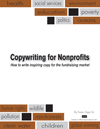When you publish that email, direct mail letter, tweet, or Facebook update … what are you offering donors? And are you making it an attractive offer that they don’t want to ignore?
 Yes, your offer and call-to-action (CTA) is – in my opinion – one of THE most critical elements in your appeal.
Yes, your offer and call-to-action (CTA) is – in my opinion – one of THE most critical elements in your appeal.
It’s so important that this is the first part of a package I write. Specifically the P.S. for direct mail and email; plus the reply device for direct mail.
.
What makes a good offer?
1) A clearly explained problem the donor will help to solve by taking your desired action (giving; signing a petition; etc.). Within the body of the letter or email you describe it in detail through storytelling and emotional copy.
But the P.S. has to capture the guts of the issue in a sentence or two so that by reading nothing more, the donor is already leaning toward making a response. Not easily done.
And that’s why I start here because if I can sum it all up passionately and tightly in the P.S., I can write a stronger letter or email where the problem unfolds in detail. I’ve got my target in sight and I take a laser bead on it. My writing doesn’t wander.
2) Your problem needs a solution. How exactly will Martha Do-gooder’s money help solve the problem?
Is it going to help buy a new dialysis machine for the hospital so people like Henry (the person whose story you tell in the appeal) get better treatment? Is it going to buy 30 text books so girls in Africa get an education, learn how to earn money so the their children don’t die at age two; but rather have a chance to grow up and also be productive and happy? Will it put food on the table?
These are the points to focus on. Not solving world hunger or breaking poverty cycles. Keep it in terms donors can relate to. Keep the focus on a smaller scale so it’s clear how $25 will make a difference.
3) Impact and value. Today’s consumers and donors are looking for value as never before. And this includes wanting a solid return on their donation to your charity.
Therefore you need to show – through examples, dollars and cents, etc. – how far their money will go. How much will $25 buy? How much of an impact will it have in terms of getting medicine to a child, or in terms of influencing a change in public policy?
Be specific. Give examples. Show just how much farther their money goes than they probably thought possible.
4) Urgency. Why should Martha Do-gooder give today? What are the dire consequences if she doesn’t act today? What happens to others when she delays?
And as you write the offer and its related CTA, spell it all out clearly. Especially if you’re asking the donor to do more than one thing (e.g., donate and sign a petition).
If you haven’t used emotion, storytelling, tangible examples, and convincing arguments to make your case . . . then the donor won’t know what problem they help to solve by giving … they won’t know why they ought to care and how you’ll use their money . . . they won’t see the value in helping your cause and certainly won’t feel like it’s anything they have to worry about today (i.e., urgency).
Spend time crafting a strong offer. Write it first. There’s a lot competing for your donors’ money. Don’t get lazy or arrogant and assume your mission is so important that you can avoid writing an exceptional appeal with an equally exceptional offer.
Related posts:
4 Ways to Add Urgency to Nonprofit Offers
Your Direct Mail Package Isn’t Complete Until the Reply Device “Sings”
Saving a life through nonprofit copywriting
